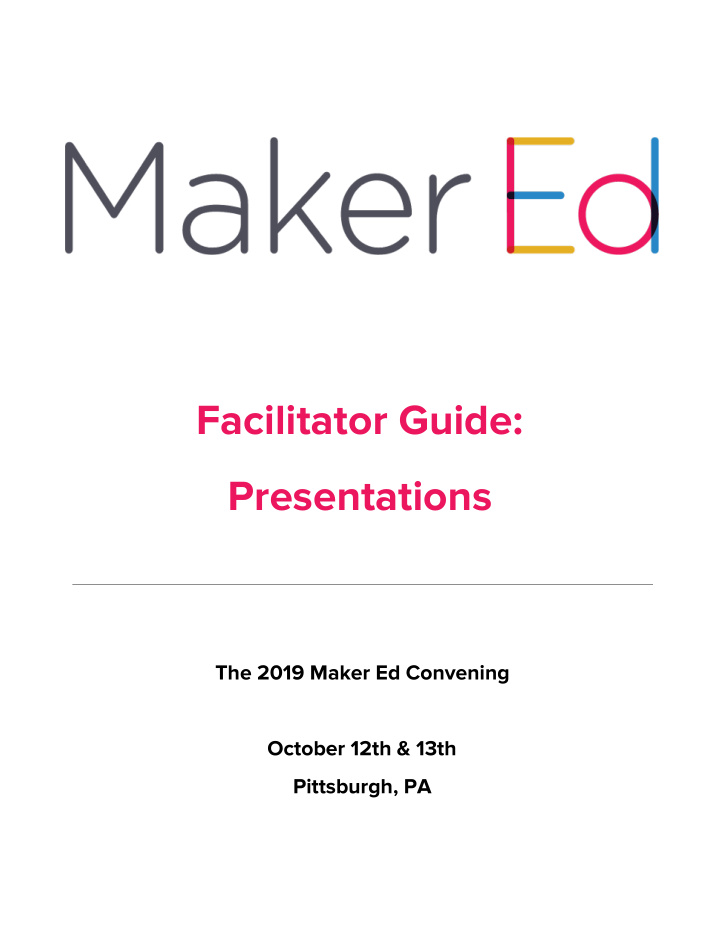



Facilitator Guide: Presentations The 2019 Maker Ed Convening October 12th & 13th Pittsburgh, PA
Presentations (30 minutes) Presentations are opportunities for participants to learn from the experience of the presenter and may include elements where participants learn from each other. They should include time for participants to actively engage with the ideas presented. Maker-centered learning is learner-driven and hands-on, and Maker Ed designs our presentations to model to this style of learning. We request that, as much as possible, our partners design presentations similarly for the convening! We have broken down a presentation into core elements. Please use this guide as a starting place. In addition, we will offer support for facilitators during our Open Sessions with Maker Ed. Session Planning Start by thinking about the objectives of your session. What do you want participants to walk away understanding? Is it a specific concept, a process, or a new perspective you would like them to try on? Take a look at your proposal and think about all the things you would like participants to learn; then boil it down to 1-2 big ideas that you want to design towards. What is the core objective of your presentation? Core Element – Share Participants have the opportunity to learn about a key learning, challenge, or element of the presenters work. This is an opportunity for you to share your work and create a space where participants can engage with your ideas. Think about how you can present your work clearly and concisely; this generally means focusing deeply on the 1-2 big ideas you identified as your objectives. Be sure to provide enough context so participants understand your big ideas, but keep it focused! Use up to half the time to present your work.
Core Element – Reflect and/or Apply Participants understand, articulate, and make meaning out of their experience, discover the relevance of their experience to their own practice, and/or envision applying a new idea to their own learning environment. How will you invite the participants to reflect on the learning objectives and apply them to their own context? What will participants reflect on? Will the reflection focus on pure introspection, sharing their learning and/or applying their learning to their own context? How will you structure participant reflection & application? Will you ask a 1-2 questions, ● use a thinking routine, or leave space for open reflection? Will you give them time to reflect & apply individually, in small groups, in the whole ● group? How will you make their reflections & applications visible to the group? ● Will you project questions or create a handout? ● See the resources section for possible structures. Core Element – Intro & Closing Participants feel welcome, understand what to expect from the session, and have an opportunity to synthesize the experience at the end. Intro – How will you welcome and orient participants? What information do you need to ● share at the beginning? What information can wait until after participants have experienced parts of the session? Closing – How will you support participants to synthesize learning and come back to the ● learning objectives?
Optional Elements + Other Design Considerations These components can happen as part of the make/do and reflect components or independently, but may not be included due to limited time. Make/Do – Participants engage in a hands-on and minds-on thinking process. We highly ● encourage the use of make/do in presentations even if it is in a brief activity. Document – Participants record their process and make it visible. ● These are other considerations and resources for you as you prepare for your session at the convening. Timing – How do you offer ample time for the core elements of share and ● reflection/application? Plan your presentation so it doesn’t feel rushed. Getting Started – Give participants an opportunity to actively early on. This will set the ● tone that everyone is expected to actively participate in the presentation. Participation – It is important to vary participation to maximize individual participation. ● One way to accomplish this is to shift between individual, small group, and whole group during your presentation. Facilitation How the presentation is facilitated is as important as the design of the session. How do you plan to facilitate the session? How are you creating a space where participants are able to figure out key learnings for themselves, where participants are learning from each other, where community is being built while learning, or where the tools and materials themselves are teachers? What role will you play in this space? Facilitation Resources: We often draw from the following resources when planning for our presentations: Thinking Routines ● Agency by Design Thinking Routines + Tools + Practices ● Liberating Structures ● National School Reform Faculty ● Storytelling Tips & Tricks – The Moth ● Why Bad Presentations Happen to Good Causes ●
Recommend
More recommend